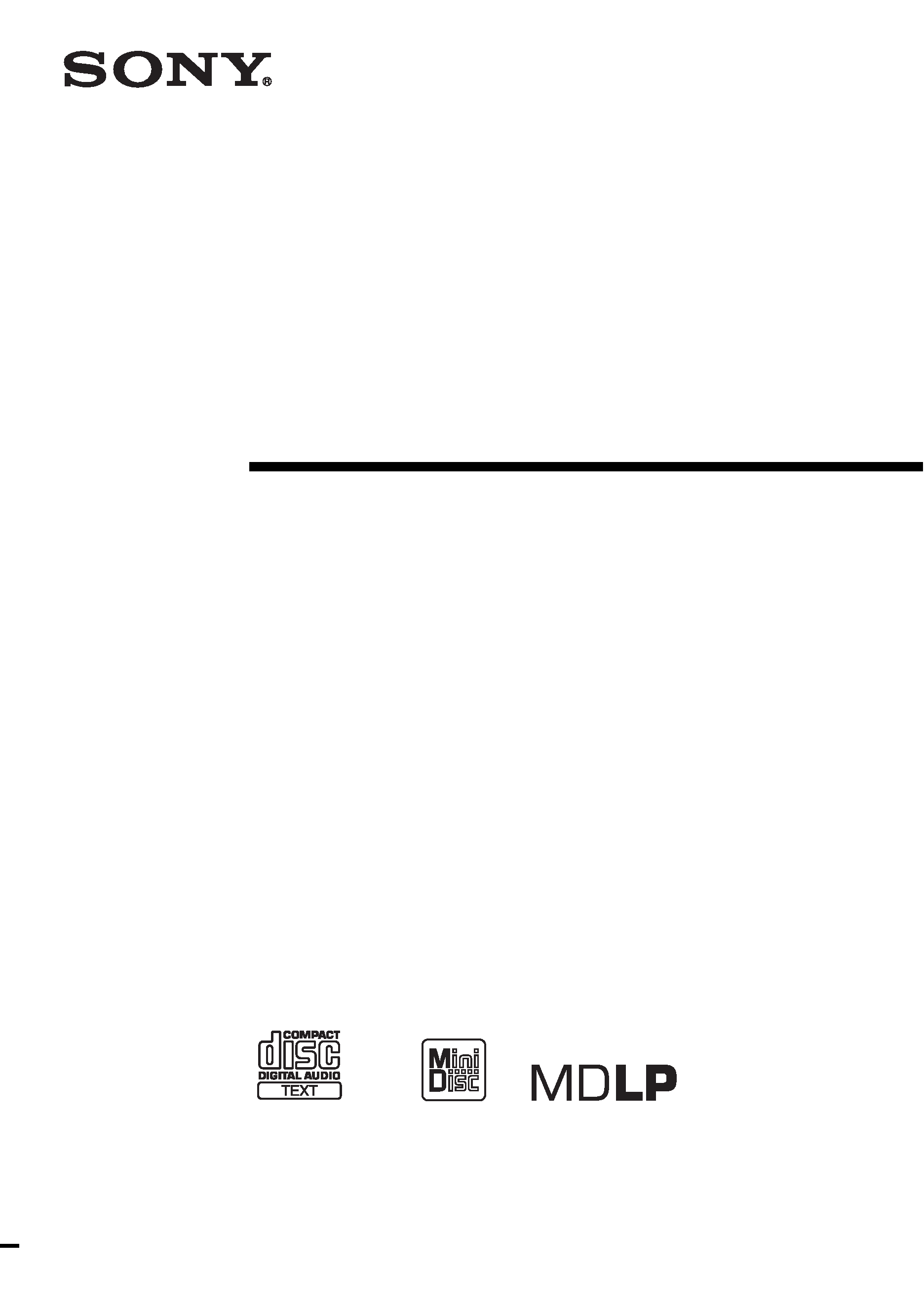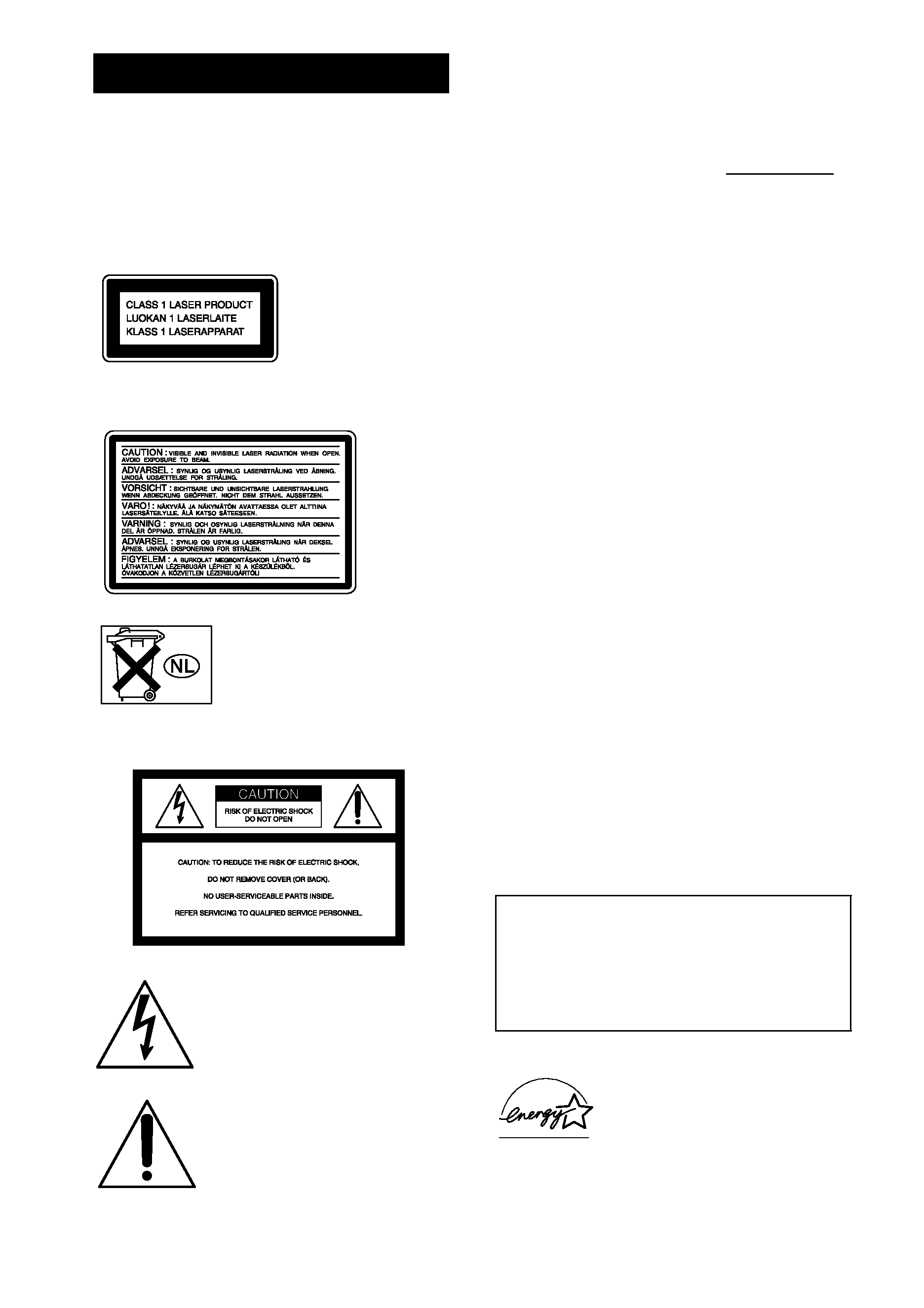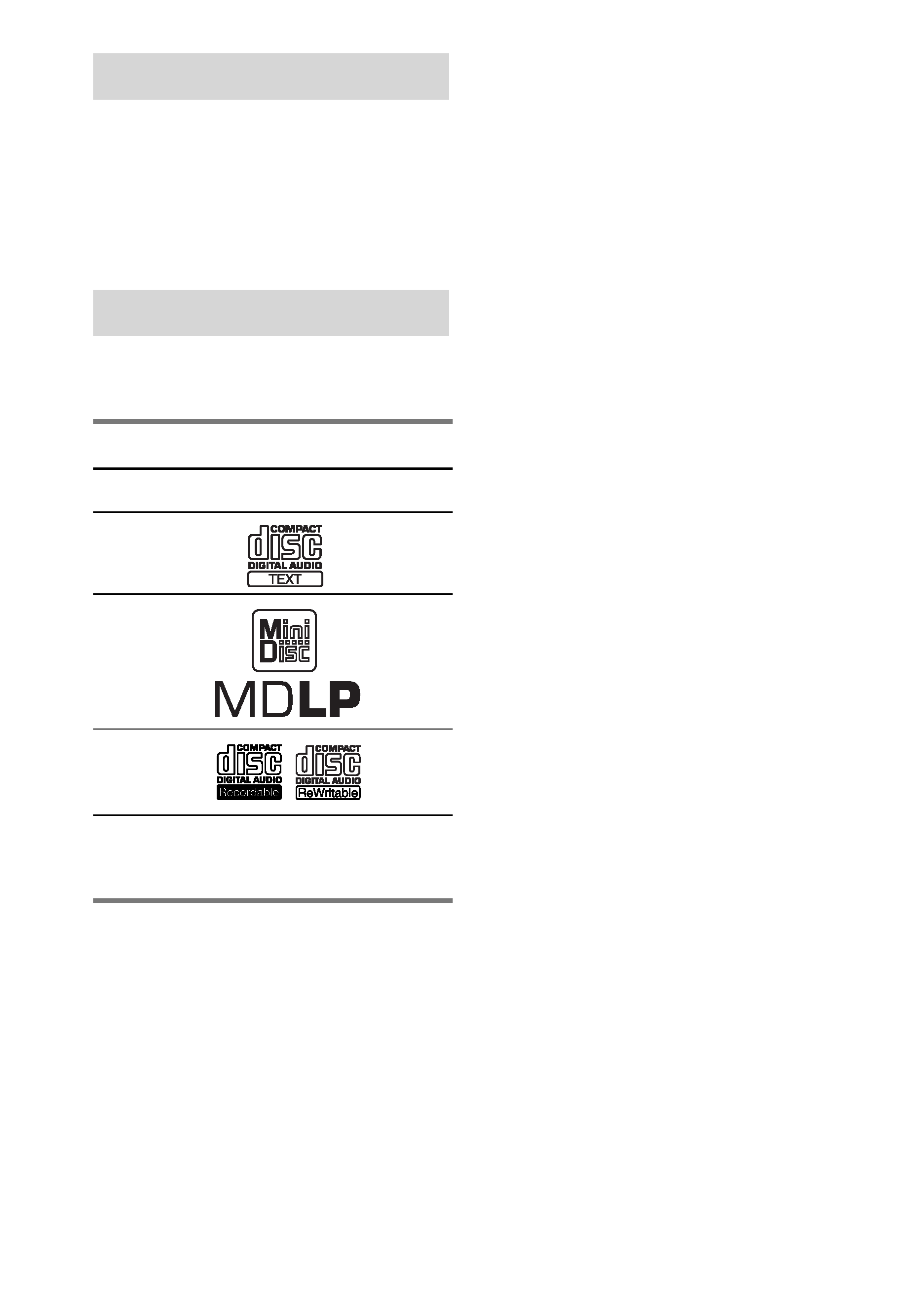
©2003 Sony Corporation
4-245-486-11(2)
Compact Disc
MiniDisc Deck
Operating Instructions
MXD-D400

2GB
To prevent fire or shock hazard, do not
expose the unit to rain or moisture.
To prevent fire, do not cover the ventilation of the
apparatus with news papers, table-cloths, curtains, etc.
And don't place lighted candles on the apparatus.
To prevent fire or shock hazard, do not place objects
filled with liquids, such as vases, on the apparatus
This appliance is
classified as a CLASS 1
LASER product. This
label is located on the
rear exterior.
The following caution label is located inside the
apparatus.
Don't throw away the battery
with general house waste,
dispose of it correctly as
chemical waste.
For the customer in the U.S.A.
This symbol is intended to alert the
user to the presence of uninsulated
"dangerous voltage" within the
product's enclosure that may be of
sufficient magnitude to constitute a
risk of electric shock to persons.
This symbol is intended to alert the
user to the presence of important
operating and maintenance
(servicing) instructions in the
literature accompanying the
appliance.
Owner's Record
The model and serial numbers are located on the rear
of the unit. Record the serial number in the space
provided below. Refer to them whenever you call upon
your Sony dealer regarding this product.
Model No. MXD-D400 Seral No.
Caution
The use of optical instruments with this product will
increase eye hazard.
WARNING
This equipment has been tested and found to comply
with the limits for a Class B digital device, pursuant to
Part 15 of the FCC Rules. These limits are designed to
provide reasonable protection against harmful
interference in a residential installation. This
equipment generates, uses, and can radiate radio
frequency energy and, if not installed and used in
accordance with the instructions, may cause harmful
interference to radio communications. However, there
is no guarantee that interference will not occur in a
particular installation. If this equipment does cause
harmful interference to radio or television reception,
which can be determined by turning the equipment off
and on, the user is encouraged to try to correct the
interference by one or more of the following measures:
Reorient or relocate the receiving antenna.
Increase the separation between the equipment and
receiver.
Connect the equipment into an outlet on a circuit
different from that to which the receiver is
connected.
Consult the dealer or an experienced radio/TV
technician for help.
CAUTION
You are cautioned that any changes or modifications
not expressly approved in this manual could void your
authority to operate this equipment.
Except for European model
ENERGY STAR® is a U.S.
registered mark. As an ENERGY
STAR® partner, Sony Corporation
has determined that this product
meets the ENERGY STAR®
guidelines for energy efficiency.
WARNING
IN NO EVENT SHALL SELLER BE LIABLE
FOR ANY DIRECT, INCIDENTAL OR
CONSEQUENTIAL DAMAGES OF ANY
NATURE, OR LOSSES OR EXPENSES
RESULTING FROM ANY DEFECTIVE
PRODUCT OR THE USE OF ANY PRODUCT.

3GB
How to use this manual........................... 4
Playable discs.......................................... 4
Getting Started
Unpacking ............................................... 7
Hooking up.............................................. 7
CD/MP3/MD Play
Loading a CD .......................................... 9
Playing a CD ........................................... 9
-- Normal Play/Shuffle Play/Search Play
Playing an MP3 file .............................. 10
-- Normal Play/Shuffle Play/Search Play
Loading an MD ..................................... 11
Playing an MD ...................................... 12
-- Normal Play/Shuffle Play
Locating a specific track ....................... 13
--AMS Function
Playing repeatedly................................. 14
-- Repeat Play
Creating your own program .................. 14
-- Program Play
Playing only the tracks in the desired
group ............................................... 15
Falling asleep to music.......................... 16
-- Sleep Timer
Changing the pitch of the MD .............. 17
-- Pitch Control Function
Using the display................................... 18
MD Recording
Before you start recording .................... 19
Recording a CD on an MD ................... 20
-- CD-MD Synchro Recording/High-
Speed CD-MD Synchro Recording
Recording on an MD manually............. 21
-- Manual Recording
Starting recording with 6 seconds of
prestored audio data........................ 22
-- Time Machine Recording
Marking track numbers ......................... 23
Making a space between tracks 3 seconds
long automatically .......................... 24
-- Smart Space
Adjusting the recording level ............... 25
-- Music Synchro-Recording
Recording the current CD track............ 27
-- REC-IT Function
Synchro-Recording with an external audio
equipment ....................................... 27
Fading in and out .................................. 28
-- Fader
Recording tips....................................... 29
MD Editing
Editing tips............................................ 30
Registering tracks in groups ................. 31
-- Group Function
Labeling an MD/group/track ................ 32
-- Name Function
Creating a new group............................ 34
-- Create Function
Releasing group registrations ............... 35
-- Release Function
Erasing recordings ................................ 36
-- Erase Function
Moving recorded tracks ........................ 38
-- Move Function
Combining recorded tracks................... 39
-- Combine Function
Dividing recorded tracks ...................... 40
-- Divide Function
Undoing the last edit............................. 41
-- Undo Function
Changing the recorded level after recording 41
-- S.F Edit Function
Troubleshooting
Problems and remedies ......................... 43
Self-diagnosis display........................... 44
Messages............................................... 45
Additional Information
Precautions............................................ 46
System limitations of MDs ................... 47
Specifications........................................ 48
List of button locations and reference
pages............................................... 49
Table of Contents

4GB
· Before operating the deck, connect your deck
by referring to "Getting Started."
· This manual mainly explains operations using
the remote, but the same operations can also
be performed using the buttons on the deck
having the same or similar names.
You can play back the following discs on this
deck. Other discs cannot be played back.
List of playable discs
You can play MP3 files on the deck. For details,
see "Playing a disc with MP3 files" on page 5.
Discs that this deck cannot
play
· CD-ROMs (PHOTO CDs included)
· CD-Rs/CD-RWs other than those recorded in
the following formats:
music CD format
MP3 format that conforms to ISO9660*
Level 1/Level 2, Romeo or Joliet
* A logical format of files and folders on CD-ROMs,
defined by ISO (International Standard
Organization)
Notes on CD-R and CD-RW
· This deck can play CD-R/CD-RW discs
edited by the user. However, note that
playback of some discs may not be possible
depending on the recording device used for
recording or the disc condition.
· CD-R and CD-RW discs that have not been
finalized (processing to allow play by a
normal CD player) cannot be played.
· The deck may be unable to play MP3 format
files that do not have the extender ".MP3" at
the end of the file name.
· Attempting to play non-MP3 format files that
have the extender ".MP3" may result in noise
or malfunction.
· The recommended bit rate for playing MP3
files is 128kbps or more.
· Playback of dtsCDs or recording from digital
dtsCDs to MDs is not supported.
Music discs encoded with
copyright protection
technologies
This product is designed to playback discs that
conform to the Compact Disc (CD) standard.
Recently, various music discs encoded with
copyright protection technologies are marketed
by some record companies. Please be aware that
among those discs, there are some that do not
conform to the CD standard and may not be
playable by this product.
How to use this manual
Playable discs
Format of
discs
Disc logo
Contents
Audio CDs
Audio
MD
Audio
CD-R/CD-RW
Audio

5GB
Playing a disc with MP3 files
About MP3 files
MP3 (MPEG 1 Audio Layer-3) is a standard
technology and format for compressing a sound
sequence. The file is compressed to about 1/10
of its original size. Sounds outside the range of
human hearing are compressed while the sounds
we can hear are not compressed.
Playback of same MP3 files may not be
possible, depending on the recording.
The encoding method (i.e., the bit rate selected
for encoding) will affect the sound quality of the
MP3 files created. The bit rate typically used for
MP3 files is 128 kbps.
About ID3 tags
An ID3 tag is song information (such as track
name, album title, and artist name) that is
attached to MP3 files.
Notes on discs
You can play MP3 files recorded on CD-ROMs, CD-
Rs (recordable CDs), and CD-RWs (rewritable CDs).
The disc must be in the ISO 9660*1 level 1 or level 2
format, or Joliet or Romeo in the expansion format.
You can use a disc recorded in Multi Session*2.
*1ISO 9660 Format
The most common international standard for the
logical format of the files and folders on a CD-ROM.
There are several specification levels. In Level 1, file
names must be in the 8.3 format (no more than eight
characters in the name, no more than three characters
in the extension ".MP3") and in capital letters. Folder
names can be no longer than eight characters. There
can be no more than eight nested folder levels. Level
2 specifications allow file names up to 31 characters
long.
For Joliet or Romeo in the expansion format, make
sure of the contents of the writing software, etc.
*2Multi Session
This is a recording method that enables adding of
data using the Track-At-Once method.
Conventional CDs begin at a CD control area called
the Lead-in and end at an area called Lead-out. A
Multi Session CD has multiple sessions, with each
Lead-in to Lead-out segment regarded as a single
session.
CD-EXTRA: A format in which CD-DA (audio) data
are recorded in the tracks of session 1 and computer
data in the tracks of session 2.
Mixed CD: A format in which computer data are
recorded in the first track and CD-DA (audio) data in
the following tracks within a session.
Notes
· With format other than ISO 9660 level 1, folder
names or file names may not be displayed correctly.
· When naming, be sure to add the file extension
".MP3" to the file name.
· If you add the extension ".MP3" to a file other than
MP3, the unit cannot recognize the file properly and
will generate random noise that could damage your
speakers.
· The following discs take a longer time to start
playback.
a disc recorded with a complicated tree structure.
a disc recorded in Multi Session.
Cautions when playing a disc that is
recorded in Multi Session
CD-DA (audio) data or MP3 files stored on a Multi
Session CD may be subject to some restrictions on
playback.
If the disc begins with a CD-DA session, it is
recognized as a CD-DA (audio) disc, and playback
continues until an MP3 session is encountered.
If the disc begins with an MP3 session, it is
recognized as an MP3 disc, and playback continues
until a CD-DA (audio) session is encountered.
The playback range of an MP3 disc is determined by
the tree structure of files produced by analyzing of
the disc.
A disc with a mixed CD format will be recognized as
a CD-DA (audio) disc.
